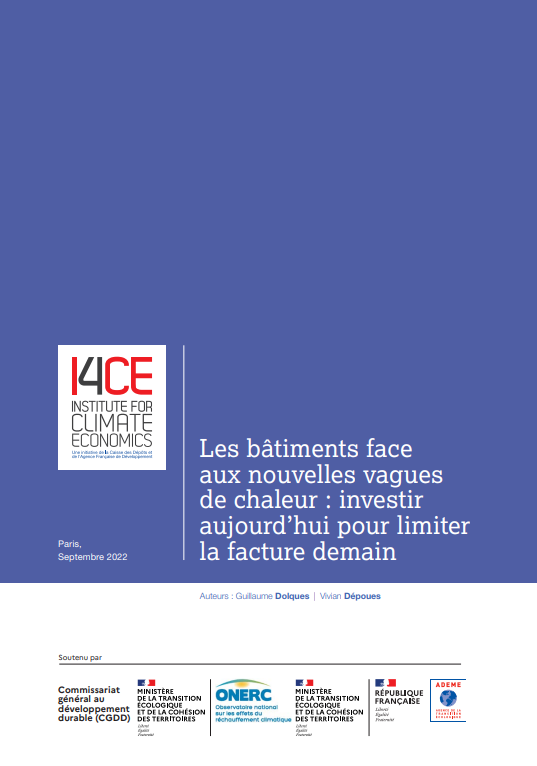Buildings new heat waves: invest today to limit the bill tomorrow
Over 35°C in exam halls during the French baccalaureate, inhabitants affected by their residences overheated… Summer 2022 has once again shown that our buildings aren’t adapted for the new heat waves. And yet every year, tens of billions of euros are invested in construction and renovation projects that don’t always take climate change into account. In this study, I4CE proposes immediate actions on three levers to initiate the process of adapting our buildings, and three more structural changes, including changes to thermal regulations.
Report only available in French
Buildings are not designed to cope with increasingly intense heat waves
Over 35°C in some examination rooms during the French baccalaureate exams in June, residents suffering from overheating in poorly insulated homes. The summer of 2022 has once again shown that buildings are not designed to cope with the new heat waves we’re experiencing. And this is just the beginning: Météo France (the French national agency for meteo and climate predictions) predicts that heatwaves will become more frequent and more severe, whatever the emission scenario considered. The question of personal discomfort is gradually becoming a more fundamental issue of building habitability (or operability in the case of industrial or commercial buildings), directly affecting health and safety issues. It therefore seems unthinkable that buildings constructed or renovated today do not systematically take this issue into account. Yet neither building regulations, whose calculation rules are based on past climatic conditions, nor public financial aid encourage buildings to take account the expected future climate. Differently, every year, tens of billions of euros – including a significant proportion of public money – are invested in construction and renovation projects that will soon prove unsuited to new climatic conditions. In some cases, these investments even exacerbate the problem by financing buildings dependent on air-conditioning, or renovation operations which, while providing energy savings in winter, prove counter-productive in summer.
Designing buildings adapted to climate change: it’s already possible
Our analysis of existing literature on the topic, and our interviews with industry stakeholders, show that taking greater account of summer comfort in a building, in a sustainable way and without recourse to air-conditioning, generally poses no major technical difficulty. It’s first of all a question of the willingness to incorporate this concern into the project’s specifications. In most situations, this can be achieved at an additional cost of around ten percent. In all cases, designing buildings adapted to climate change from the moment they are built, or when they are renovated, will be cheaper than having to reinvest in adapting buildings, and will avoid massive recourse to air-conditioning, with its negative energy and environmental externalities. Integrating climate change into all construction and renovation projects from the outset is therefore a key factor in the efficiency of public spending.
Three levers to activate to initiate an ambitious adaptation dynamic
- Systematically take climate change into account in public real estate projects. The French government, local authorities and public agencies could immediately include summer comfort criteria in the specifications for their own real estate projects – particularly when they concern sensitive public buildings and uses (e.g. school buildings, social housing, etc.) – that go beyond actual thermal regulations. For example, in the case of teaching and research buildings, this would represent an additional annual investment effort of around €500 million/year on a current investment estimated at €4.9 billion/year.
- Redirect renovation aids towards deep, and high-performance operations. By 2021, over €6.9 billion will have been paid spent in energy renovation grants. Most of the renovation work financed in this way has been limited to a single item of work (roof insulation, changing the heating system, etc.). But to properly address summer comfort, it needs to be part of a project that simultaneously addresses all the levers for improving the building, not only in terms of comfort, but also energy consumption and greenhouse gas emissions. This is yet another argument in favor of redirecting public funding towards dep renovation projects, which also offer other advantages in terms of meeting carbon neutrality targets.
- Support the industry’s skills development through research, ecosystem development and training. Given the scale and speed of the transformations required, investment is needed to create a favorable environment and support the industry. This support will involve training for the various stakeholders in the building sector, as well as stepping up research into technical solutions, providing leadership and training to accelerate the dissemination of best practices, and making appropriate climatic information available. As part of the Quanti-Adapt project, we have estimated the funding requirements associated with such a package of actions at around €31 million per year.
Click here to see “31 M€/year to support the industry’s skills development” in French
In the longer term, we need to consider more structural changes to ensure that the building stock is truly adapted to the needs of the sector.
- Adapt thermal regulations to take account of climate change in calculation models. From today, an “adapted building” criterion could be included in the label accompanying the RE2020, for which consultation is still underway.
- Take greater account of adaptation in urban planning documents. Urban planning documents, through the provisions they incorporate, have a strong influence on the development choices made for a neighborhood or a building. It is important to take advantage of the time when these documents are being drawn up or revised, firstly to ensure that they do not hinder good adaptation practices, but above all to encourage the implementation of adapted projects.
- Encourage social landlords and building stock managers to integrate adaptation to climate change. Summer comfort in a building must become a performance criterion in the same way as energy savings. To achieve this, economic incentives or regulatory provisions could be envisaged to encourage them to objectify the vulnerability of their stock, deal with emergencies, and anticipate climate change in future construction and renovation operations.


